Abstract
Zn-Ag alloys are deemed extremely promising materials for manufacturing biodegradable medical implants. Nonetheless, their practical applications are still constrained by inferior mechanical properties. To tackle this issue, Zn-0.5Ag alloy was alloyed with Mg (0.2 wt.%) and processed by combined equal-channel angular pressing (ECAP) and rolling, with different rolling reductions (40%, 60%, and 75%). ECAP-processed Zn-0.5Ag-0.2Mg alloy exhibited superior mechanical properties to its as-cast counterpart. Subsequent rolling of 40% further enhances the mechanical performance of ECAP-processed Zn-0.5Ag-0.2Mg alloy, with yield strength (YS), ultimate tensile strength (UTS), and elongation (EL) reaching 255 MPa, 309 MPa, and 52%, respectively, surpassing the application requirements. As the rolling reduction increased to 60% and further to 75%, YS and UTS declined, whereas EL rose continuously. The underlying mechanisms for the variation in strength and ductility were elucidated based on microstructure evolution analysis through optical microscopy (OM), scanning electron microscopy (SEM), and electron backscatter diffraction (EBSD) characterizations.
1. Introduction
Biomedical implants play an indispensable role in treating various diseases [1,2]. Conventional implants are generally fabricated from corrosion-resistant metals such as Ti alloys [3] and stainless steel [4]. They commonly necessitate secondary removal surgery, boosting medical costs as well as the physical and mental suffering of patients [5,6]. Biodegradable medial implants have been proposed as a solution for addressing this issue. Zn alloys are promising candidate materials for fabricating biodegradable medical implants, owing to their merits such as moderate degradation rates and superior biocompatibility [7]. Recently, Zn-Ag alloys have emerged as a research hotspot due to their inherent antimicrobial capability, derived from the release of silver ions, thereby substantially mitigating infection risks [8,9,10].
Nonetheless, Zn-Ag alloys exhibit mechanical properties that are significantly inferior to the requirements of medical implants (YS ≥ 230 MPa, UTS ≥ 300 MPa, and EL ≥ 20%) [11]. Alloying and severe plastic deformation (SPD) are common strategies for enhancing the mechanical performance of metals. Zn-Ag alloys have been further alloyed with various elements including Cu [12,13,14,15,16], Zr [12,17], Mn [12,16,18,19], Mg [8,14,20,21,22,23,24,25], Ti [13], and Sc [26]. A variety of SPD techniques including ECAP [15,27,28,29,30,31], hot extrusion [8,12,17,18,32,33,34], and high-pressure torsion (HPT) [34,35] have been employed to process Zn-Ag based alloys. Alloying can lead to the formation of new phases such as (Ag, Cu)Zn4 [36], Zn22Zr [17], MnZn13 [18], Mg2Zn11 [8], and ScZn12 [26]. Fine precipitates strengthen Zn alloys through precipitation strengthening [37]. Second phase particles with a size larger than 1 μm promote dynamic recrystallization (DRX) during SPD through the particle-stimulated nucleation (PSN) mechanism [38]. SPD processing can induce significant grain refinement and dynamic precipitation of nanosized precipitates and increase dislocation density. Previous studies demonstrate that alloying and SPD enhance the mechanical performance of Zn-Ag alloys [5]. For example, hot-extruded Zn-0.1Ag-0.05Mg alloy exhibits a UTS of 247.8 MPa and an EL of 35% [8]. ECAP-processed Zn-2Ag alloy possesses an ultrahigh EL of 197% but a low UTS of 125 MPa [30]. HPT processed Zn-0.8Ag alloy shows a YS of 185 MPa [35]. Despite tremendous efforts, the strength and ductility of Zn-Ag based alloys developed so far rarely meet the application requirements.
SPD-processed Zn-Mg alloys commonly exhibit very high strength but poor ductility [5]. A hot-extruded Zn-1.6Mg alloy has a very high UTS of 365 MPa, but it is plagued by a low EL of 6% [39]. The low EL is related to a coarse Mg2Zn11 phase formed due to the addition of too much Mg. Inspired by this, a Zn-0.5Ag alloy was alloyed with minor Mg (0.2 wt.%) in this work. Previous studies [40,41] reported that combined ECAP and rolling endows hexagonal close-packed metallic materials such as Mg alloys with mechanical performance better than that of their counterparts processed by rolling or ECAP. Therefore, in this work, a Zn-0.5Ag-0.2Mg alloy was processed by combined ECAP and rolling, with an aim of enhancing its mechanical performance. Three different rolling reductions (40%, 60%, and 75%) were employed to investigate the influence of rolling reduction on the microstructure and mechanical properties of the Zn-0.5Ag-0.2Mg alloy. Interestingly, the Zn-0.5Ag-0.2Mg alloy processed by combined ECAP and rolling exhibits mechanical properties significantly superior to its counterpart processed by ECAP. The underlying mechanisms behind the variation in mechanical properties are discussed.
2. Experimental Procedure
In this work, to develop Zn-Ag-based alloys satisfying the application requirements of medical implants, Zn-0.5Ag alloy was further alloyed with 0.2 wt.% Mg and processed by combined ECAP and rolling, with different rolling reductions (40%, 60%, and 75%). The designed Zn-0.5Ag-0.2Mg alloy was prepared through conventional melting and casting techniques. The as-cast alloy was heat-treated and then processed by combined ECAP and rolling. Mechanical properties were evaluated by tensile tests. Microstructure characterization was performed by OM and SEM. The effect of rolling reduction on microstructure and mechanical properties was analyzed. The detailed experimental procedure is given as follows.
Raw materials for fabricating Zn-0.5Ag-0.2Mg alloy are pure Zn (99.99 wt.%), pure Ag (99.99 wt.%), and pure Mg (99.99 wt.%). They were dried at 200 °C for 12 h in a drying oven before use. Placed in a graphite crucible, raw materials were heated to 650 °C by a pit-type electric resistance furnace and held for 1 h at 650 °C. Subsequently, the melt was cast into a steel mold (with an inner dimension of 200 × 50 × 50 mm3). The graphite crucible and steel mold were coated with zinc oxide and then dried in a drying oven before use. The melting and casting processes were conducted under the protection of mixed CO2 (99 vol.%) and SF6 (1 vol.%). Subsequently, the obtained ingot was machined into 19.5 × 19.5 × 45 mm3 sized samples using wire-cut electrical discharge machining and then homogenized at 350 °C for 4 h. Homogenized samples were heated to 250 °C and underwent ECAP processing for 8 passes. ECAP was performed by rotary-die ECAP equipment [42]. ECAP-processed samples were named ECAP alloy. ECAP alloy was then rolled with three different rolling reductions (40%, 60%, and 75%) at room temperature. Samples rolled by 40%, 60%, and 75% were named ER 40%, ER 60%, and ER 75% alloy, respectively.
Tensile tests were performed by a universal testing machine (Suns UTM4294X, Jinan Hensgrand Instrument Limited Company, Jinan, China) with a strain rate of 10−3/s. Tensile test samples are dog-bone-shaped with a gauge length of 6 mm. An extensometer was used to measure the axial strain. Microstructure characterization was conducted by OM (Olympus BHM, Tokyo, Japan) and SEM (Hitachi Regulus8100, Tokyo, Japan) with an EBSD system and an energy-dispersive X-ray spectrometer (EDS). OM and SEM samples were prepared by mechanical grinding (using 180# to 2000# SiC abrasive papers), polishing (using 2.5 μm diamond paste), and etching (using a solution of H2O (10 mL), CrO3 (2 g), and Na2SO4 (0.15 g)). EBSD samples were electrolytic-polished at a current density of 450 mA/cm2 for approximately 4.5 min with a solution of C2H5OH (95%) and HClO4 (5%). EBSD data analysis was performed with HKL Channel 5 software. The grain sizes of as-cast and homogenized alloys were evaluated by the intercept method [43].
3. Results and Discussion
3.1. Microstructure Evolution
OM images of as-cast and homogenized alloys are displayed in Figure 1. Grains of as-cast alloy are very coarse, possessing an average grain size (AGS) of approximately 51.8 μm. Homogenization induces grain growth, with the AGS increasing to 181.4 μm. SEM images of the ECAP, ER 40%, ER 60%, and ER 75% alloys are exhibited in Figure 2. The chemical composition of points A~E in Figure 2 is given in Table 1. Noticeably, numerous second-phase particles with a size ranging from submicron to micron exist in the ECAP, ER 40%, ER 60%, and ER 75% alloys, as marked by points B~E. The chemical composition of points B~E analyzed by EDS reveals that they correspond to a Mg2Zn11 phase. Owing to the negligible room-temperature solubility of Mg in Zn, minor addition of Mg to Zn and its alloys induces the formation of a Mg2Zn11 phase, as reported by previous studies [39,44].
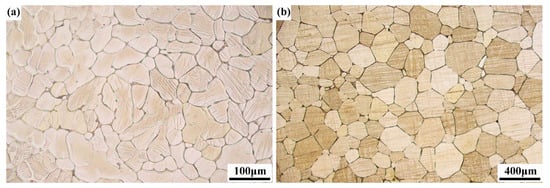
Figure 1.
OM images of (a) as-cast Zn-0.5Ag-0.2Mg alloy and (b) homogenized Zn-0.5Ag-0.2Mg alloy.
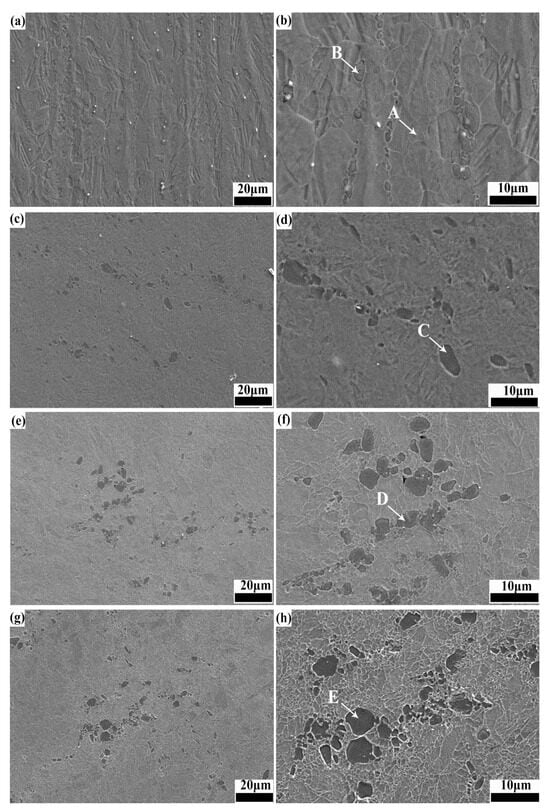
Figure 2.
SEM images of (a,b) ECAP, (c,d) ER 40%, (e,f) ER 60%, and (g,h) ER 75% alloys.

Table 1.
Chemical composition of points A~E in Figure 2 analyzed by EDS (in atomic percentage).
EBSD images exhibiting inverse pole figures (IPFs) and grain size distribution histograms of ECAP, ER 40%, ER 60%, and ER 75% alloys are displayed in Figure 3. Note from Figure 3a that the microstructure of the ECAP alloy is dominated by equiaxed and fine grains, exhibiting an AGS of 7.46 μm, significantly smaller than that of the as-cast alloy. This significant grain refinement is attributed to DRX caused by ECAP. Plastic deformation-induced DRX of Zn alloys has been widely reported by previous studies [28,45]. Mg2Zn11 particles play a role in the DRX of the alloy. Micron-sized Mg2Zn11 particles promote DRX via PSN mechanism [38]. Moreover, submicron-sized Mg2Zn11 particles exert Zener pinning effect on grain growth, facilitating grain refinement [18]. Noticeably, subsequent rolling of 40% further refines grains, with the AGS reducing to 4.43 μm. In addition, as the rolling reduction increases to 60% and further to 75%, the AGS declines to 3.93 μm and further to 1.91 μm, respectively.
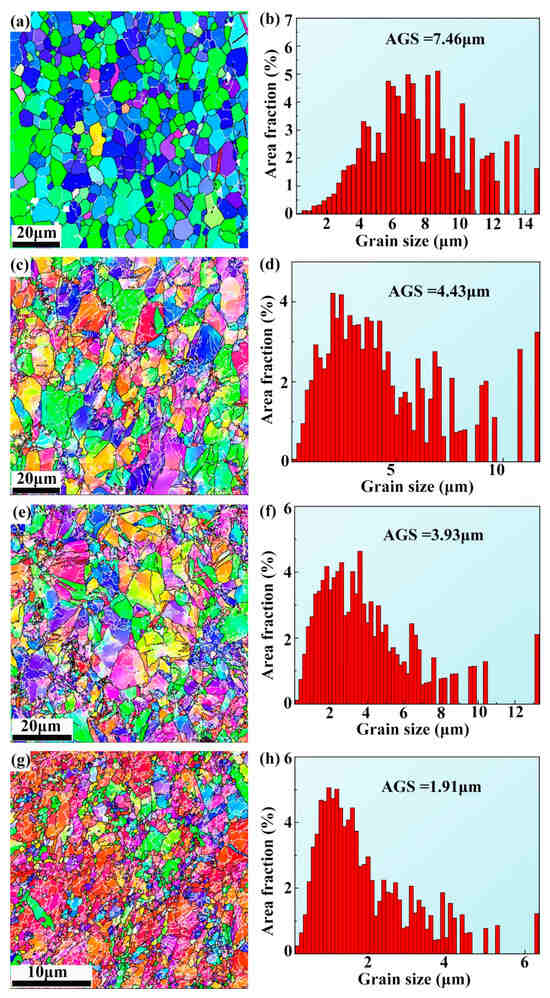
Figure 3.
IPF of (a) ECAP, (c) ER 40%, (e) ER 60%, and (g) ER 75% alloys; grain size distribution histogram of (b) ECAP, (d) ER 40%, (f) ER 60%, and (h) ER 75% alloys.
Figure 4 displays grain boundary maps and misorientation angle distribution histograms of ECAP, ER 40%, ER 60%, and ER 75% alloys. The low frequency (18.8%) of LAGBs in the ECAP alloy indicates a high degree of DRX, consistent with the equiaxed grains observed in the IPF image (Figure 3a). Indeed, the degree of DRX in the ECAP alloy is high, as displayed in Figure 5. The ER 40% alloy possesses the highest frequency (39.7%) of LAGBs. With the rolling reduction increases to 60% and further to 75%, the frequency of LAGBs decreases to 34.7% and 33.8%, respectively. The high frequency of LAGBs in the alloy processed by combined ECAP and rolling is ascribed to the high percentage of substructured and deformed grains formed by rolling.
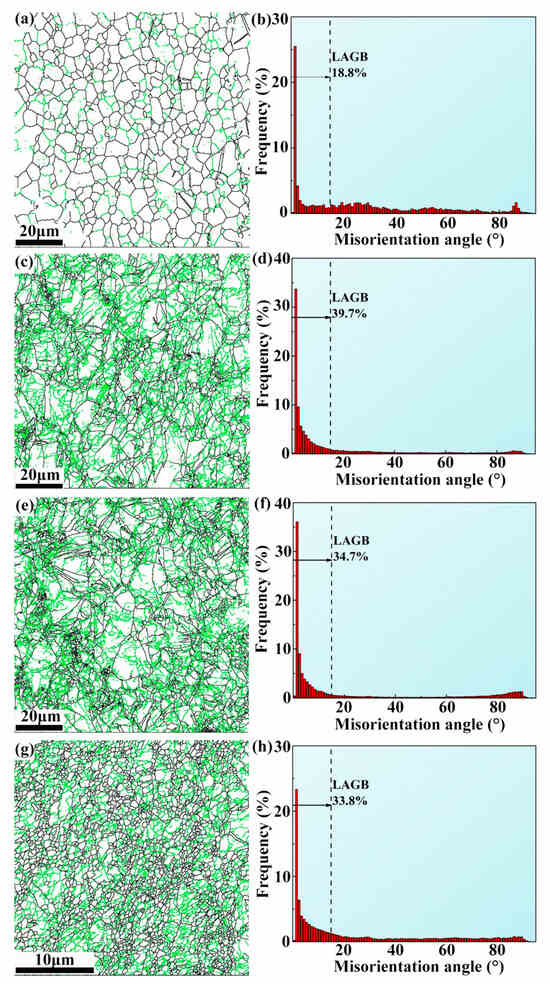
Figure 4.
Grain boundary map of (a) ECAP, (c) ER 40%, (e) ER 60%, and (g) ER 75% alloys, where green lines represent low-angle grain boundaries (LAGBs, with a misorientation angle of 2°~15°) while black lines denote high-angle grain boundaries (HAGBs, with a misorientation angle exceeding 15°); misorientation angle distribution histogram of (b) ECAP, (d) ER 40%, (f) ER 60%, and (h) ER 75% alloys.

Figure 5.
EBSD images displaying recrystallized (blue), substructured grains (yellow), and deformed grains (red) in (a) ECAP, (b) ER 40%, (c) ER 60%, and (d) ER 75% alloys; (e) histogram of different types of grains.
A kernel average misorientation (KAM) map and local misorientation angle distribution histogram of ECAP, ER 40%, ER 60%, and ER 75% alloys are exhibited in Figure 6. A KAM map is regarded as a measure of distribution of local lattice strain and dislocation, where elevated KAM values correlate with increased dislocation densities [46]. The ECAP alloy has a low average KAM of 0.42°, implying a low dislocation density. The low dislocation density is associated with the high degree of DRX of the ECAP alloy. DRX is a process involving the rearrangement and annihilation of dislocations [47]. Although numerous dislocations are generated during ECAP, they are mostly consumed by DRX. Therefore, the dislocation density in the ECAP alloy is low. Subsequent rolling of 40% significantly increases dislocation density, as implied by the greatly elevated average KAM of 0.76°. The variation in dislocation density is a result of the competition between dislocation formation by rolling and dislocation consumption by DRX. In cases of rolling reduction of 40% and 60%, dislocations formed by rolling overwhelm dislocations consumed by DRX due to the low degree of DRX. Consequently, dislocation density is higher than that in the ECAP alloy, as implied by increased average KAM values. TEM images exhibiting dislocations in the ER 40% alloy are displayed in Figure 7. As the rolling reduction increases to 75%, dislocation consumption by DRX overwhelms dislocation formation by increased rolling reduction, leading to decreased dislocation density.
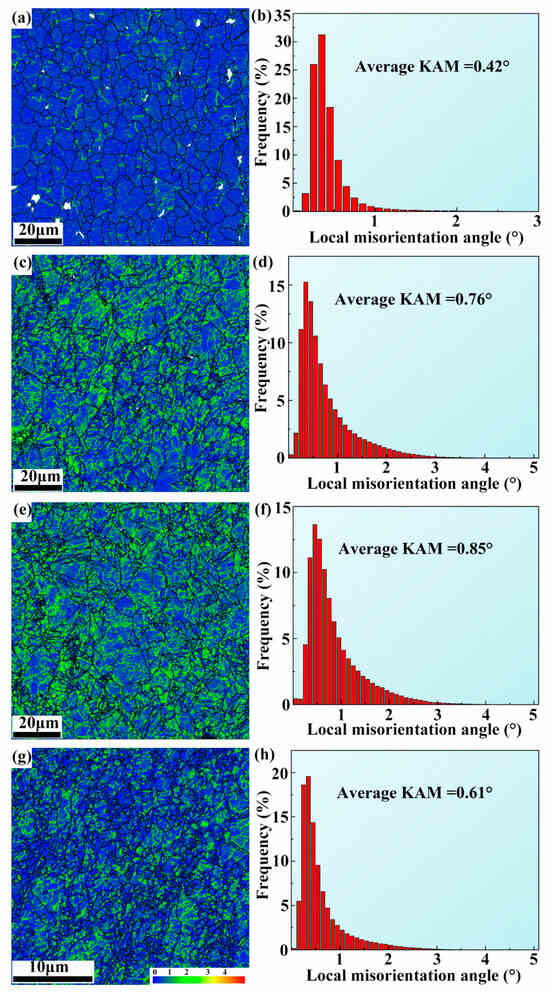
Figure 6.
KAM map of (a) ECAP, (c) ER 40%, (e) ER 60%, and (g) ER 75% alloys; local misorientation angle distribution histogram of (b) ECAP, (d) ER 40%, (f) ER 60%, and (h) ER 75% alloys.
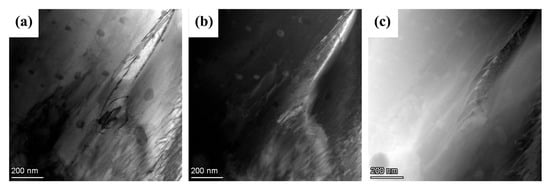
Figure 7.
TEM images displaying dislocations in the ER 40% alloy (a) bright field, (b) dark field, and (c) high-angle annular dark field.
3.2. Mechanical Properties
Engineering stress–strain curves of as-cast, ECAP, ER 40%, ER 60%, and ER 75% alloys are displayed in Figure 8. The YS, UTS, and EL of them are shown in Table 2. The as-cast alloy exhibits quite poor mechanical properties, with a YS of 111 MPa, a UTS of 122 MPa, and an EL of 4%. ECAP significantly enhances the mechanical performance of the alloy, elevating the YS, UTS, and EL to 151 MPa, 197 MPa, and 32%, respectively. Subsequent rolling further improves mechanical properties. The ER 40% alloy displays a YS of 255 MPa, 309 MPa, and 52%, surpassing the requirements of medical implants. Interestingly, as the rolling reduction increases to 60% and further 75%, YS and UTS decline whereas EL rises continuously. The ER 40% alloy exhibits the best strength–ductility combination. A comparison on mechanical properties between ER 40% alloy and other recently developed Zn-Ag based alloys is given in Table 3. Noticeably, the mechanical properties of ER 40% alloy are excellent.
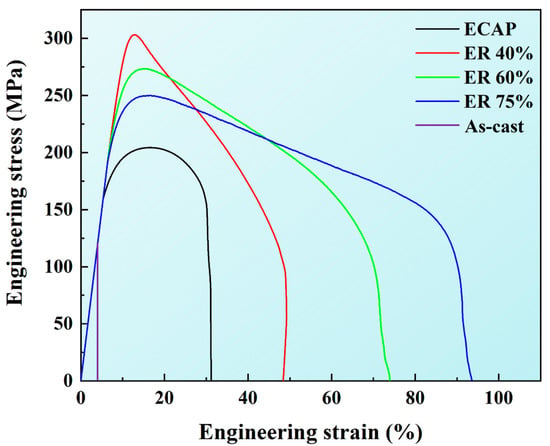
Figure 8.
Engineering stress–strain curves of as-cast, ECAP, ER 40%, ER 60%, and ER 75% alloys.

Table 2.
YS, UTS, and EL of as-cast, ECAP, ER 40%, ER 60%, and ER 75% alloys.

Table 3.
A comparison on mechanical properties between ER 40% alloy and other recently developed Zn-Ag based alloys.
The main mechanisms for strengthening metals include fine grain strengthening, dislocation strengthening, solid solution strengthening, and precipitation strengthening [50]. The Hall–Petch equation is commonly employed to estimate fine grain strengthening. According to this equation, YS () is related to AGS () by
where and represent lattice friction stress and Hall–Petch slope, respectively [51]. The Bailey–Hirsch relation is generally used to evaluate dislocation strengthening . According to this relation, is associated with dislocation density () by
where , , , and denote the Taylor factor, constant, shear modulus, and Burgers vector of basal slip, respectively [52]. It is obvious from Equation (2) that a higher dislocation density results in stronger dislocation strengthening. Solid solution strengthening () correlates with lattice distortion caused by solute atoms, which induces increased dislocation motion resistance [53]. It is evaluated by
where is the strengthening coefficient, denotes a positive exponent, and represents solute atom concentration [35]. Note from Equation (3) that solid solution strengthening is positively correlated with solute atom concentration. Precipitation strengthening () is widely attributed to the Orowan mechanism, wherein dislocations bypass non-shearable precipitates. It is estimated by
where and denote the average distance between precipitates and the average size of precipitates, respectively [37].
The ECAP alloy possesses significantly refined grains compared to the as-cast alloy. The tremendously enhanced YS of the ECAP alloy is mainly ascribed to fine grain strengthening. Compared to the ECAP alloy, the ER 40% alloy has finer grains (Figure 3) and higher dislocation density (Figure 6). Consequently, the higher YS of the ER 40% alloy mainly derives from fine grain strengthening and dislocation strengthening. As the rolling reduction increases to 60%, grains are further refined (Figure 3) and, meanwhile, the dislocation density is further elevated (Figure 6). Based on Equations (1) and (2), the ER 60% alloy should have a higher YS than the ER 40% alloy. Nonetheless, unexpectedly, the YS of the ER 60% alloy is lower. Previous studies ascribed such a grain refinement softening phenomenon to grain boundary sliding (GBS) [35]. With the further increase in rolling reduction to 75%, grains are finer, and dislocation density is lower. Therefore, the decreased YS of the ER 75% alloy is attributed to grain refinement softening and decreased dislocation strengthening. In contrast to YS, EL exhibits a rising trend with increasing rolling reduction, which is related to enhanced GBS activity induced by decreasing grain size. GBS can tremendously improve ductility and even lead to superplasticity [28]. In addition, the decreasing dislocation density with increasing rolling reduction also contributes to increasing EL.
4. Conclusions
In this study, a Zn-0.5Ag-0.2Mg alloy was processed by combined ECAP and rolling with three different rolling reductions (40%, 60%, and 75%). ECAP significantly refines grains and thus enhances the mechanical properties of the as-cast alloy. Subsequent rolling further refines grains and improves mechanical performance. The AGS exhibits a decreasing trend with increasing rolling reduction. Interestingly, YS and UTS decrease while EL increases as the rolling reduction increases from 40% to 60% and further to 75%. ER 40% exhibits the best mechanical performance with a YS of 255 MPa, 309 MPa, and 52%, surpassing the requirements of medical implants. Strength enhancement is mainly ascribed to grain refinement strengthening and dislocation strengthening. The decrease in strength with increasing rolling reduction derives from the grain refinement softening induced by grain boundary sliding. This study offers valuable insights into the development of high-performance Zn alloys for biomedical and industrial applications. Nonetheless, the corrosion rate, which is an important factor to be considered when designing biodegradable medical implants, was not investigated in this work. Future attention should be paid to the corrosion behavior of the developed Zn-Ag-Mg alloys.
Author Contributions
Conceptualization, X.Z. and S.J.; methodology, Y.X.; software, P.Z., X.C. and T.H.; validation, X.Z., Y.X. and S.J.; formal analysis, X.Z., Y.X. and S.J.; investigation, Y.X., P.Z., X.C. and T.H.; data curation, X.C., P.Z. and T.H.; writing—original draft preparation, X.Z. and Y.X.; writing—review and editing, X.Z. and S.J.; funding acquisition, S.J. All authors have read and agreed to the published version of the manuscript.
Funding
This research was funded by Key Projects of the National Institute of Metrology (No. AKYZZ2540) and Key Projects of the Shenzhen Science and Technology Program (No. JCYJ20220818103601003).
Institutional Review Board Statement
Not applicable.
Informed Consent Statement
Not applicable.
Data Availability Statement
The data that support the findings of this study are available from the corresponding author on reasonable request.
Conflicts of Interest
The authors declare no conflicts of interest.
References
- Zhang, S.; Fang, H.; Tian, H. Recent Advances in Degradable Biomedical Polymers for Prevention, Diagnosis and Treatment of Diseases. Biomacromolecules 2024, 25, 7015–7057. [Google Scholar] [CrossRef] [PubMed]
- Athmuri, D.N.; Bhattacharyya, J.; Bhatnagar, N.; Shiekh, P.A. Alleviating hypoxia and oxidative stress for treatment of cardiovascular diseases: A biomaterials perspective. J. Mater. Chem. B 2024, 12, 10490–10515. [Google Scholar] [CrossRef] [PubMed]
- Henriksen, N.G.; Poulios, K.; Somers, M.A.J.; Christiansen, T.L. Impact of laser marking on microstructure and fatigue life of medical grade titanium. Mater. Sci. Eng. A 2023, 873, 145020. [Google Scholar] [CrossRef]
- Tur, D.; Tian, Z.; Giannis, K.; Unger, E.; Mittlboeck, M.; Rausch-Fan, X.; Strbac, G.D. A comparative in vitro study on heat generation with static guided and conventional implant bed preparation using stainless steel twist drills and a standardized bovine model. Materials 2025, 18, 1277. [Google Scholar] [CrossRef] [PubMed]
- Zhuo, X.; Wu, Y.; Ju, J.; Liu, H.; Jiang, J.; Hu, Z.; Bai, J.; Xue, F. Recent progress of novel biodegradable zinc alloys: From the perspective of strengthening and toughening. J. Mater. Res. Technol. 2022, 17, 244–269. [Google Scholar] [CrossRef]
- Zhang, Z.; He, D.; Zheng, Y.; Wu, Y.; Li, Q.; Gong, H.; Ma, X.; Li, Y. Microstructure and mechanical properties of hot-extruded Mg-2Zn-xGa (x = 1, 3, 5 and 7 wt.%) alloys. Mater. Sci. Eng. A 2022, 859, 144208. [Google Scholar] [CrossRef]
- Kabir, H.; Munir, K.; Wen, C.; Li, Y. Recent research and progress of biodegradable zinc alloys and composites for biomedical applications: Biomechanical and biocorrosion perspectives. Bioact. Mater. 2021, 6, 836–879. [Google Scholar] [CrossRef]
- Chen, K.; Ge, W.; Zhao, L.; Kong, L.; Yang, H.; Zhang, X.; Gu, X.; Zhu, C.; Fan, Y. Endowing biodegradable Zinc implants with dual-function of antibacterial ability and osteogenic activity by micro-addition of Mg and Ag (≤0.1 wt.%). Acta Biomater. 2023, 157, 683–700. [Google Scholar] [CrossRef]
- Zhang, E.; Zhao, X.; Hu, J.; Wang, R.; Fu, S.; Qin, G. Antibacterial metals and alloys for potential biomedical implants. Bioact. Mater. 2021, 6, 2569–2612. [Google Scholar] [CrossRef]
- Venezuela, J.; Dargusch, M.S. The influence of alloying and fabrication techniques on the mechanical properties, biodegradability and biocompatibility of zinc: A comprehensive review. Acta Biomater. 2019, 87, 1–40. [Google Scholar] [CrossRef]
- Mostaed, E.; Sikora-Jasinska, M.; Drelich, J.W.; Vedani, M. Zinc-based alloys for degradable vascular stent applications. Acta Biomater. 2018, 71, 1–23. [Google Scholar] [CrossRef] [PubMed]
- Guillory, R.J., II; Mostaed, E.; Oliver, A.A.; Morath, L.M.; Earley, E.J.; Flom, K.L.; Kolesar, T.M.; Mostaed, A.; Summers, H.D.; Kwesiga, M.P.; et al. Improved biocompatibility of Zn-Ag-based stent materials by microstructure refinement. Acta Biomater. 2022, 145, 416–426. [Google Scholar] [CrossRef]
- Heiss, A.; Thatikonda, V.S.; Richter, A.; Schmitt, L.-Y.; Park, D.; Klotz, U.E.E. Development, Processing and Aging of Novel Zn-Ag-Cu Based Biodegradable Alloys. Materials 2023, 16, 3198. [Google Scholar] [CrossRef] [PubMed]
- Jara-Chavez, G.; Amaro-Villeda, A.; Campillo-Illanes, B.; Ramirez-Argaez, M.; Gonzalez-Rivera, C. Effect of Ag and Cu Content on the Properties of Zn-Ag-Cu-0.05Mg Alloys. Metals 2024, 14, 740. [Google Scholar] [CrossRef]
- Khafizova, E.; Fakhretdinova, E.; Islamgaliev, R.; Polenok, M.; Sitdikov, V.; Yilmazer, H. Effect of Plastic Deformation on the Structure and Mechanical Properties of the Zn-4Ag-1Cu Zinc Alloy. Materials 2023, 16, 4646. [Google Scholar] [CrossRef] [PubMed]
- Niu, K.; Zhang, D.; Qi, F.; Lin, J.; Dai, Y. The effects of Cu and Mn on the microstructure, mechanical, corrosion properties and biocompatibility of Zn-4Ag alloy. J. Mater. Res. Technol. 2022, 21, 4969–4981. [Google Scholar] [CrossRef]
- Wątroba, M.; Bednarczyk, W.; Kawałko, J.; Mech, K.; Marciszko, M.; Boelter, G.; Banzhaf, M.; Bała, P. Design of novel Zn-Ag-Zr alloy with enhanced strength as a potential biodegradable implant material. Mater. Des. 2019, 183, 108154. [Google Scholar] [CrossRef]
- Mostaed, E.; Sikora-Jasinska, M.; Ardakani, M.S.; Mostaed, A.; Reaney, I.M.; Goldman, J.; Drelich, J.W. Towards revealing key factors in mechanical instability of bioabsorbable Zn-based alloys for intended vascular stenting. Acta Biomater. 2020, 105, 319–335. [Google Scholar] [CrossRef]
- Niu, K.-N.; Zhang, D.-C.; Qi, F.-G.; Lin, J.-G.; Dai, Y.-L. Achieving high strength and antibacterial Zn-4Ag-Mn alloy with homogenous corrosion behavior via high-pressure solid solution. Trans. Nonferrous Met. Soc. China 2024, 34, 2231–2244. [Google Scholar] [CrossRef]
- Ramirez–Ledesma, A.L.; Domínguez–Contreras, L.A.; Juarez–Islas, J.A.; Paternoster, C.; Mantovani, D. Influence of cross—Rolling on the microstructure and mechanical properties of Zn bioabsorbable alloys. Mater. Lett. 2020, 279, 128504. [Google Scholar] [CrossRef]
- Ramirez-Ledesma, A.L.; Roncagliolo-Barrera, P.; Alvarez-Perez, M.A.; Juarez-Islas, J.A.; Paternoster, C.; Copes, F.; Mantovani, D. Introducing novel bioabsorbable Zn-Ag-Mg alloys intended for cardiovascular applications. Mater. Today Commun. 2023, 35, 105544. [Google Scholar] [CrossRef]
- Wątroba, M.; Mech, K.; Bednarczyk, W.; Kawałko, J.; Marciszko-Wiąckowska, M.; Marzec, M.; Shepherd, D.E.T.; Bała, P. Long-term in vitro corrosion behavior of Zn-3Ag and Zn-3Ag-0.5Mg alloys considered for biodegradable implant applications. Mater. Des. 2022, 213, 110289. [Google Scholar] [CrossRef]
- Wang, J.; Xia, H.; Fan, X.; Wu, H.; Liao, Y.; Yuan, F. Biodegradable Zn-2Ag-0.04Mg Alloy for Bone Regeneration In Vivo. Mol. Biotechnol. 2022, 64, 928–935. [Google Scholar] [CrossRef] [PubMed]
- Wu, H.; Xie, X.; Wang, J.; Ke, G.; Huang, H.; Liao, Y.; Kong, Q. Biological properties of Zn–0.04Mg–2Ag: A new degradable zinc alloy scaffold for repairing large-scale bone defects. J. Mater. Res. Technol. 2021, 13, 1779–1789. [Google Scholar] [CrossRef]
- Zhuo, X.-R.; Huang, T.-C.; Huang, Y.-H.; Dong, X.-B.; Zhao, L.-Y.; Wang, X.-J.; Xu, G.-X.; Qiao, Y.-X.; Jiang, J.-H.; Ma, A.-B.; et al. Strengthening Zn-Ag alloys with Mg addition. J. Iron Steel Res. Int. 2024. [Google Scholar] [CrossRef]
- Tong, X.; Shen, X.; Lin, Z.; Lu, L.; Munir, K.; Zhou, R.; Zhu, L.; Li, Y.; Ma, J.; Wen, C.; et al. In vitro and in vivo studies of a biodegradable Zn-4Ag-0.1Sc alloy with high strength-elongation product, cytocompatibility, osteogenic differentiation, and anti-infection properties for guided bone-regeneration membrane applications. Chem. Eng. J. 2024, 493, 152763. [Google Scholar] [CrossRef]
- Bednarczyk, W.; Wątroba, M.; Kawałko, J.; Bała, P. Can zinc alloys be strengthened by grain refinement? A critical evaluation of the processing of low-alloyed binary zinc alloys using ECAP. Mater. Sci. Eng. A 2019, 748, 357–366. [Google Scholar] [CrossRef]
- Bednarczyk, W.; Wątroba, M.; Kawałko, J.; Bała, P. Determination of room-temperature superplastic asymmetry and anisotropy of Zn-0.8Ag alloy processed by ECAP. Mater. Sci. Eng. A 2019, 759, 55–58. [Google Scholar] [CrossRef]
- Carluccio, D.; Demir, A.G.; Bermingham, M.J.; Dargusch, M.S. Challenges and Opportunities in the Selective Laser Melting of Biodegradable Metals for Load-Bearing Bone Scaffold Applications. Metall. Mater. Trans. A 2020, 51, 3311–3334. [Google Scholar] [CrossRef]
- Claudia, G.-M.; Ivan, G.; Laia, O.-M.; Emilio, J.-P.; Maria-Pau, G.; Maurizio, V.; Luis, C.J.; Marta, P. Influence of ECAP process on mechanical, corrosion and bacterial properties of Zn-2Ag alloy for wound closure devices. Mater. Des. 2023, 228, 111817. [Google Scholar] [CrossRef]
- Zhuo, X.; Zhao, L.; Liu, H.; Qiao, Y.; Jiang, J.; Ma, A. A high-strength and high-ductility Zn–Ag alloy achieved through trace Mg addition and ECAP. Mater. Sci. Eng. A 2023, 881, 145381. [Google Scholar] [CrossRef]
- Qu, X.; Yang, H.; Jia, B.; Wang, M.; Yue, B.; Zheng, Y.; Dai, K. Zinc alloy-based bone internal fixation screw with antibacterial and anti-osteolytic properties. Bioact. Mater. 2021, 6, 4607–4624. [Google Scholar] [CrossRef] [PubMed]
- Sikora-Jasinska, M.; Mostaed, E.; Mostaed, A.; Beanland, R.; Mantovani, D.; Vedani, M. Fabrication, mechanical properties and in vitro degradation behavior of newly developed Zn–Ag alloys for degradable implant applications. Mater. Sci. Eng. C 2017, 77, 1170–1181. [Google Scholar] [CrossRef]
- Wątroba, M.; Bednarczyk, W.; Kawałko, J.; Lech, S.; Wieczerzak, K.; Langdon, T.G.; Bała, P. A Novel High-Strength Zn-3Ag-0.5Mg Alloy Processed by Hot Extrusion, Cold Rolling, or High-Pressure Torsion. Metall. Mater. Trans. A 2020, 51, 3335–3348. [Google Scholar] [CrossRef]
- Bednarczyk, W.; Kawałko, J.; Rutkowski, B.; Wątroba, M.; Gao, N.; Starink, M.J.; Bała, P.; Langdon, T.G. Abnormal grain growth in a Zn-0.8Ag alloy after processing by high-pressure torsion. Acta Mater. 2021, 207, 108154. [Google Scholar] [CrossRef]
- Chen, C.; Yue, R.; Zhang, J.; Huang, H.; Niu, J.; Yuan, G. Biodegradable Zn-1.5Cu-1.5Ag alloy with anti-aging ability and strain hardening behavior for cardiovascular stents. Mater. Sci. Eng. C 2020, 116, 111172. [Google Scholar] [CrossRef]
- Sun, W.T.; Qiao, X.G.; Zheng, M.Y.; Xu, C.; Kamado, S.; Zhao, X.J.; Chen, H.W.; Gao, N.; Starink, M.J. Altered ageing behaviour of a nanostructured Mg-8.2Gd-3.8Y-1.0Zn-0.4Zr alloy processed by high pressure torsion. Acta Mater. 2018, 151, 260–270. [Google Scholar] [CrossRef]
- Robson, J.D.; Henry, D.T.; Davis, B. Particle effects on recrystallization in magnesium-manganese alloys: Particle-stimulated nucleation. Acta Mater. 2009, 57, 2739–2747. [Google Scholar] [CrossRef]
- Kubásek, J.; Vojtěch, D.; Pospíšilová, I.; Michalcová, A.; Maixner, J. Microstructure and mechanical properties of the micrograined hypoeutectic Zn–Mg alloy. Int. J. Miner. Metall. Mater. 2016, 23, 1167–1176. [Google Scholar] [CrossRef]
- Li, Y.; Jiang, Y.; Xu, Q.; Ma, A.; Jiang, J.; Liu, H.; Yuan, Y.; Qiu, C. Achieving single-pass high-reduction rolling and enhanced mechanical properties of AZ91 alloy by RD-ECAP pre-processing. Mater. Sci. Eng. A 2021, 804, 140717. [Google Scholar] [CrossRef]
- Yuan, Y.; Ma, A.; Gou, X.; Jiang, J.; Lu, F.; Song, D.; Zhu, Y. Superior mechanical properties of ZK60 mg alloy processed by equal channel angular pressing and rolling. Mater. Sci. Eng. A 2015, 630, 45–50. [Google Scholar] [CrossRef]
- Gu, Y.; Ma, A.; Jiang, J.; Yuan, Y.; Li, H. Deformation Structure and Mechanical Properties of Pure Titanium Produced by Rotary-Die Equal-Channel Angular Pressing. Metals 2017, 7, 297. [Google Scholar] [CrossRef]
- Thorvaldsen, A. The intercept method—2. Determination of spatial grain size. Acta Mater. 1997, 45, 595–600. [Google Scholar] [CrossRef]
- Jin, H.; Zhao, S.; Guillory, R.; Bowen, P.K.; Yin, Z.; Griebel, A.; Schaffer, J.; Earley, E.J.; Goldman, J.; Drelich, J.W. Novel high-strength, low-alloys Zn-Mg (<0.1 wt% Mg) and their arterial biodegradation. Mater. Sci. Eng. C 2018, 84, 67–79. [Google Scholar] [CrossRef]
- Wang, X.; Meng, B.; Han, J.; Wan, M. Effect of grain size on superplastic deformation behavior of Zn-0.033 Mg alloy. Mater. Sci. Eng. A 2023, 870, 144877. [Google Scholar] [CrossRef]
- Zhong, Y.; Yin, F.; Sakaguchi, T.; Nagai, K.; Yang, K. Dislocation structure evolution and characterization in the compression deformed Mn-Cu alloy. Acta Mater. 2007, 55, 2747–2756. [Google Scholar] [CrossRef]
- Wu, Y.; Kou, H.; Wu, Z.; Tang, B.; Li, J. Dynamic recrystallization and texture evolution of Ti-22Al-25Nb alloy during plane-strain compression. J. Alloys Compd. 2018, 749, 844–852. [Google Scholar] [CrossRef]
- Yang, H.; Jia, B.; Zhang, Z.; Qu, X.; Li, G.; Lin, W.; Zhu, D.; Dai, K.; Zheng, Y. Alloying design of biodegradable zinc as promising bone implants for load-bearing applications. Nat. Commun. 2020, 11, 401. [Google Scholar] [CrossRef] [PubMed]
- Li, P.; Schille, C.; Schweizer, E.; Kimmerle-Mueller, E.; Rupp, F.; Han, X.; Heiss, A.; Richter, A.; Legner, C.; Klotz, U.E.; et al. Evaluation of a Zn-2Ag-1.8Au-0.2V Alloy for Absorbable Biocompatible Materials. Materials 2020, 13, 56. [Google Scholar] [CrossRef]
- Zhu, Y.; Wu, X. Heterostructured materials. Prog. Mater. Sci. 2023, 131, 101019. [Google Scholar] [CrossRef]
- Pande, C.S.; Cooper, K.P. Nanomechanics of Hall-Petch relationship in nanocrystalline materials. Prog. Mater. Sci. 2009, 54, 689–706. [Google Scholar] [CrossRef]
- Bailey, J.; Hirsch, P. The dislocation distribution, flow stress, and stored energy in cold-worked polycrystalline silver. Philos. Mag. 1960, 5, 485–497. [Google Scholar] [CrossRef]
- Shuai, C.; Zhong, S.; Dong, Z.; He, C.; Shuai, Y.; Yang, W.; Peng, S. Peritectic-eutectic transformation of intermetallic in Zn alloy: Effects of Mn on the microstructure, strength and ductility. Mater. Charact. 2022, 190, 112054. [Google Scholar] [CrossRef]
Disclaimer/Publisher’s Note: The statements, opinions and data contained in all publications are solely those of the individual author(s) and contributor(s) and not of MDPI and/or the editor(s). MDPI and/or the editor(s) disclaim responsibility for any injury to people or property resulting from any ideas, methods, instructions or products referred to in the content. |
© 2025 by the authors. Licensee MDPI, Basel, Switzerland. This article is an open access article distributed under the terms and conditions of the Creative Commons Attribution (CC BY) license (https://creativecommons.org/licenses/by/4.0/).